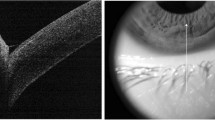Abstract
This study assessed changes in corneal and conjunctional cytology in 25 soft contact lens (CL) wearers and compared them with matched controls. We found 80% of grade IV keratinization in CL users for more than 7 years. Keratinization was directly proportional to duration of CL use. Conjunctival cytological changes worsened with decreasing pH, whereas corneal keratinization showed no significant correlation.
Similar content being viewed by others
References
DiFiore's Atlas of Histology with Functional Correlations. 8th Ed. Eroschenko, VP, ed. Philadelphia: Williams and Wilkins, 1996.
Thoft RA, Friend J. Biochemical aspect of contact lens wear. Am J Ophthalmol 1975;80:139–145.
Lowther GE, Hill RM. Corneal epithelium recovery from anoxia. Arch Ophthalmol 1974;92:231–234.
Polse KA, Decker M. Oxygen tension under a contact lens. Invest Ophthalmol Vis Sci 1979;18:188–193.
Hassell JR, Newsome DA, DeLuca L. Increased biosynthesis of specific glyconjugates in rate corneal epithelium following treatment with vitamin A. Invest Ophthalmol Vis Sci 1980:19:642–647.
Kinoshita S, Friend J, Kiorpes TC, Thoft RA. Keratin like protein in corneal and conjunctival protein epithelium are different. Invest Ophthalmol Vis Sci 1983;24:577–581.
Coles WH, Jaros PA. Dynamic ocular surface pH. Br J Ophthalmol 1984;68:549–552.
Dahl H, Dahl C. Hydrogen in concentration of tear fluid in newborn infants. Acta Ophthalmol (Copenh) 1985;63:692–694.
Holden BA, Ross R, Jenkins J. Hydrogel contact lenses impede carbon dioxide efflux from the human cornea. Curr Eye Res 1987;6:1283–1290.
Milder B. The lacrimal apparatus. In: Moses RA, ed. Alder's Physiology of the Eye: Clinical Applications. St. Louis, MO: CV Mosby, 1975.
Nom MS. Tear fluid pH in normal, contact lens wearers and pathological cases. Arch Ophthalmol (Copenhag). 1988;66:485–489.
Carney LG, Hill RM: Human Tear pH: diurnal variations. Arch Ophthalmol. 1976;94:821–824.
Vinding T, Ericksen JS, Nielsen NV. The concentration of lysozyme and secretory 19A in tears from healthy persons with and without contact lens use. Acta Ophthalmol (Copenh) 1987;65:23–26.
Singh RK. Thesis submitted for M.S. (Ophthal). 1992; B.H.U., India.
Author information
Authors and Affiliations
Corresponding author
Additional information
The authors have stated that they do not have a significant financial interest or other relationship with any product manufacturer or provider of services discussed in this article. The authors also do not discuss the use of off-label products, which includes unlabeled, unapproved, or investigative products or devices.
Rights and permissions
About this article
Cite this article
Bhatia, R.P., Lipika, R., Garbyal, R.S. et al. Corneal and conjunctival impression cytology in soft contact lens wearers. Ann Ophthalmol 38, 117–120 (2006). https://doi.org/10.1385/AO:38:2:117
Received:
Accepted:
Issue Date:
DOI: https://doi.org/10.1385/AO:38:2:117




